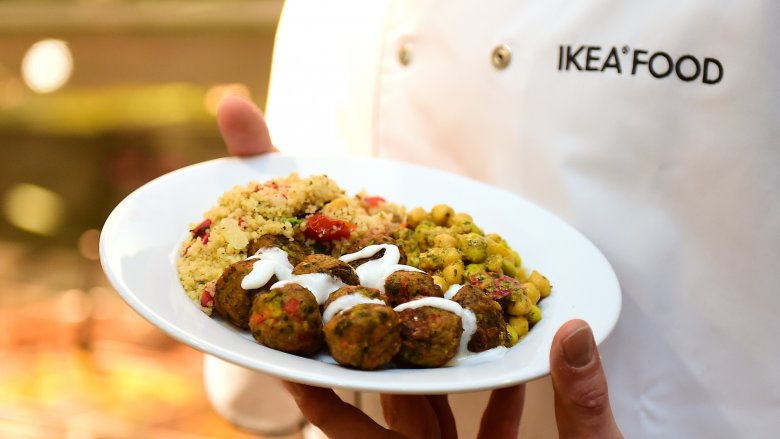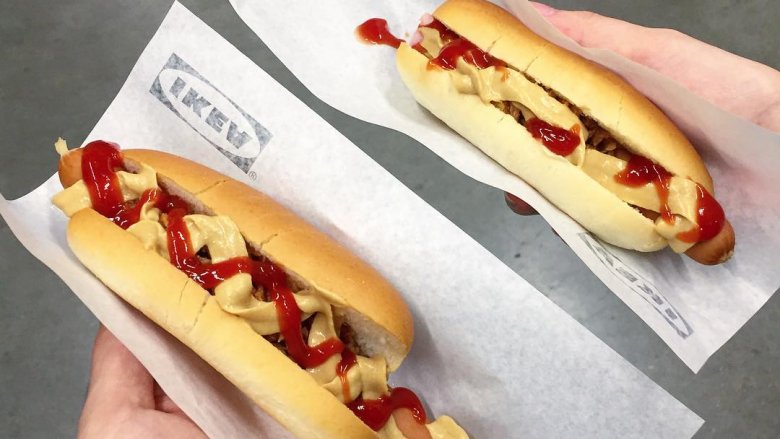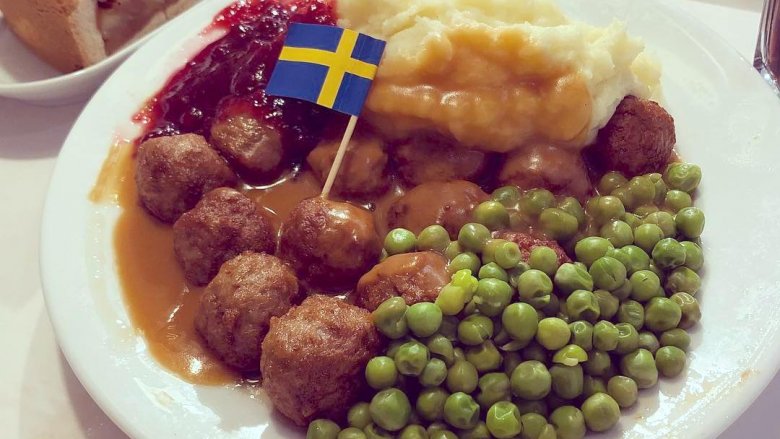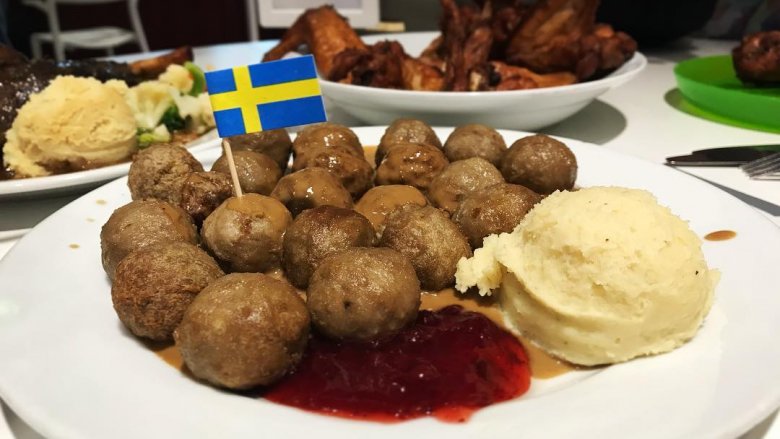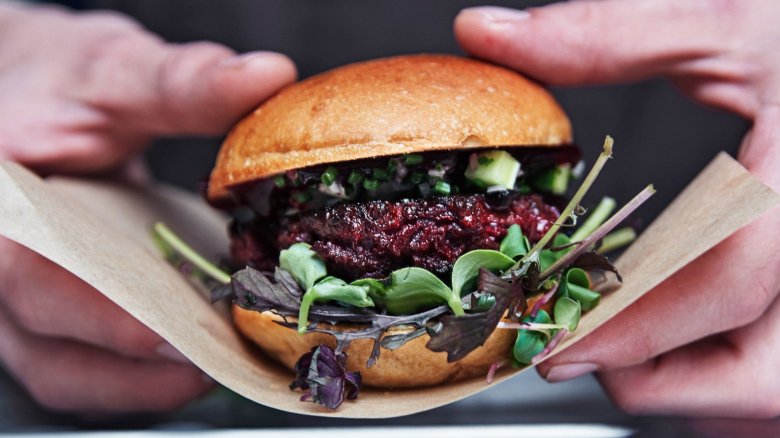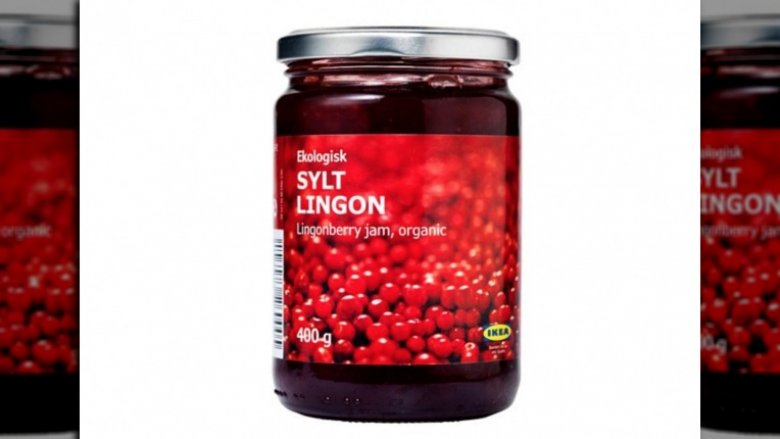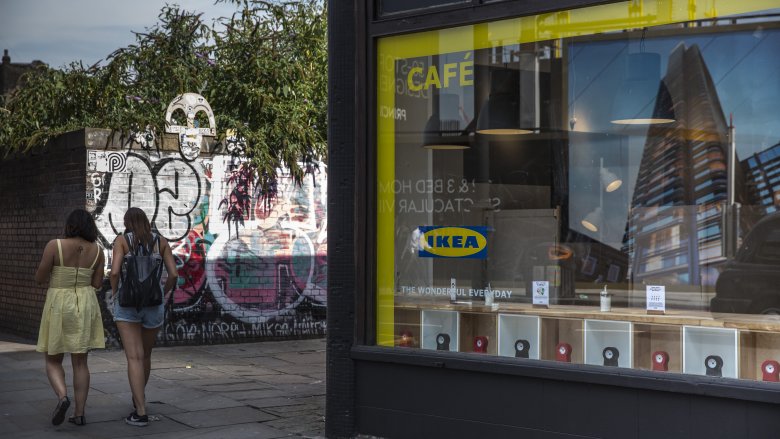The Untold Truth Of The IKEA Food Court
Admit it: You've pretended to need just one more BILLY bookcase for the sole purpose of noshing at IKEA's food court. Whether it's the $2 breakfast plate, or the iconic Swedish meatballs from the restaurant, or the unbeatable hot dog deal from the bistro, it's impossible to resist the pull of astonishingly cheap eats that — bonus — actually taste good. And hey, as long as you're there you might as well pick up a few things, right? Next thing you know your $2 eggs and potatoes have turned into $200 worth of home goods.
Turns out this was all part of IKEA founder Ingvar Kamprad's master plan in 1958, when he first decided to open cafes inside the stores. The future billionaire surmised that satiated customers might lead to an increase in sales, and he was right — to this day the store's meatballs are referred to as "the best sofa-seller." But what makes this furniture-store-turned-foodie-favorite tick? Let's find out.
The food is cheap for a reason
It's hard to beat the food prices at IKEA — where else can you get two hot dogs, chips, and a soda for $2.50? And although founder Ingvar Kamprad wanted the inexpensive offerings to give customers a "good feeling," there's another reason behind the notoriously cheap food prices. Gerd Diewald, who runs IKEA's food operations in the U.S. says, "When you feed [customers], they stay longer, they can talk about their [potential] purchases, and they make a decision without leaving the store. That was the thinking right at the beginning." That thinking has proven to be wildly successful, because while they're mulling over which couch to buy, 650 million hungry furniture shoppers are spending almost $2 billion a year in IKEA's food court.
Chris Spear, a chef who worked at an IKEA food-service operation, explains, "Their policy is to be the absolute lowest price on [an] item within a 30-mile radius, even if it means selling at a loss. They're reinforcing the low-price profile of the store. So, they take a hit on the food, but just sold you $1,000 in furniture. It's the same thing other stores do with loss leaders to get you in the door..." And what about those who dine without shopping? That's okay... IKEA figures that the next time they need a reasonably priced sofa, they'll come back.
The menu isn't as authentic as you thought
Spoiler alert: The "Swedish" meatballs, otherwise known as köttbullar, aren't actually Swedish. In April 2018, Sweden's official Twitter account inexplicably came clean with their country's "secret," tweeting, "Swedish meatballs are actually based on a recipe King Charles XII brought home from Turkey in the early 18th century. Let's stick to the facts!" While some users lamented that their "whole life had been a lie," others wanted to know if lingonberries were still Swedish. "They don't grow in Sweden exclusively. But lingonberry jam accompanying meatballs is damn near as Swedish as it gets!" the account answered. Phew!
As for the rest of the menu? Turns out it's only about 50 percent Scandinavian, with the rest of the items tailored to the specific demographic's market. If you're going for the real deal, try the gravad lax, or dill-cured salmon, which makes an appearance on any good Swedish smorgasbord, or grab a kanelbullar, which you know as a cinnamon bun, from the bistro. You'll need to consume about 316 cinnamon buns per year to eat like a true Swede. Doesn't sound so bad, does it?
You're eating the meatballs wrong
We've already learned that Swedish meatballs are actually Turkish meatballs, but regardless, you're probably not eating them like a Swede would. So what's the proper way?
First things first: Resist the urge to pop a whole meatball in your mouth — you'll only be disappointed with the flavor, or lack thereof. To do it right, order your plate with extra gravy, and always get the lingonberry jam. Cut your gravy-covered meatball in half, then dip it into the mashed potatoes followed by the jam. Don't skimp here — the lingonberry brings out a nutmeg flavor that you probably didn't even know was there.
If you want to carry your authentic experience through to dessert, skip the apple cake — it's a far cry from the real thing which would be more like a pie with a crumb topping. Go for the Daim cake instead, with black coffee. This luscious almond-chocolate-toffee treat will make you wish you were really Swedish.
Bugs in burgers?
When you think of IKEA food, the word "innovative" might not come to mind. Sure, they make solid, inexpensive dishes, but meatballs and hot dogs aren't exactly groundbreaking. Over the years, they've paid attention to their customers' desire for more plant-based options: In 2015 they introduced a vegan version of their iconic meatballs, and in early 2019 will be rolling out vegan hot dogs to the U.S. stores. But again, that's not earth-shattering stuff.
So what's this about innovation? Space10, IKEA's external innovation lab, is setting out to create "the fast food of the future" — healthy and sustainable alternatives to our usual fast food fare. Among that futuristic food is the Bug Burger, which comes complete with ground mealworm, parsnip, beetroot, and potato; the Dogless Hotdog, made up of mostly vegetables and nestled in a bright green bun thanks to spirulina (a micro-algae); and the Neatball, another chance to get your mealworm fix sans traditional protein.
Unfortunately, if your mouth is watering for a bite of the Bug Burger, you might have to wait awhile. A Space10 representative told Esquire.com that "this project is limited to culinary research, and there are no current plans to put these dishes on IKEA's menu." Fingers crossed?
What the heck is a lingonberry?
We know that Swedish meatballs and lingonberry jam go together like peanut butter and jelly, but what do you really know about lingonberries?
Turns out lingonberry jam isn't a one-hit wonder condiment that's only used with meatballs — it's used as an accompaniment to many dishes including potato pancakes (raggmunk), stuffed cabbage rolls (kåldomar), and black pudding (blodpudding). Surprisingly, one food it's not typically used on is bread.
Lingonberries, also known as cowberries, grow in the wild in the Swedish woodlands and moorlands. Though it might be tempting to pop a fresh berry into your mouth, raw lingonberries are actually very bitter with hard, shiny skins. But all it takes is a bit of sugar to transform that bitterness into the jam you know and love, which also happens to be so full of antioxidants that Swedish children are encouraged to eat it with their breakfast porridge and incorporate it into their other meals. In other words, you can feel good about using a whole jar on your next meatball plate.
Standalone restaurants might happen
Would you go to IKEA just to eat? If you answered "yes," you're not alone. A staggering 30 percent of customers dining at the IKEA food court come to the store for that sole purpose. Sometimes you've just gotta satisfy that meatball craving, right? But what if you didn't have to drive 30 minutes, then wind your way through that maze of furniture to do it?
Seeing an opportunity to reach more dining-only customers, IKEA tested several stand-alone pop-up restaurants in 2017, opening in major cities where a traditional store would not otherwise be possible. "The mere fact that we don't need so many square feet to do a café or a restaurant makes it interesting by itself," said Michael La Cour, IKEA Food's managing director. "I firmly believe there is potential. I hope in a few years our customers will be saying, 'IKEA is a great place to eat — and, by the way, they also sell some furniture.'" We hope so too, but as of 2018, IKEA has said that "no decisions on standalone restaurants have been made at this time."
The horse meat scandal
According to IKEA, their classic meatballs contain 84 percent meat — a fairly standard mixture of pork and beef. Aside from that, it's a pretty typical ingredient list: Onion, breadcrumbs, egg, salt and pepper. So what's this about horse meat?
In 2013, scandal hit IKEA when the Czech State Veterinary Administration detected horse meat in a shipment of the company's frozen meatballs, prompting the affected product to be pulled from shelves in 13 European countries. Though company representatives said the Swedish branches were unaffected, they were also pulled from the shelves in an effort to ease consumers' minds. Product in the U.S. was said to be unaffected.
Although the company said in a statement, "We take seriously the test result from the Czech Republic authorities, indicating presence of horse meat in one batch of our meatballs," they were also quick to note that testing on several frozen products, including meatballs, had been done two weeks prior, and no evidence of horse meat had been found.
There's a way to get free froyo
Don't think the IKEA food prices are quite cheap enough? Good news — there's a hack that will get you way more ice cream and frozen yogurt, free. All you have to do is trick the dispenser. Sound a little shady? While this method probably isn't condoned by IKEA, it definitely gets you more bang for your buck.
To trick the dispenser, you have to apply a bit of pressure to the arm that elevates the cup or cone. When it gets to its top position, use your fingers to keep it there just a little longer. The ice cream or froyo will continue dispensing until you release it, but be careful — hold it there too long and you'll have a sticky mess on your hands.
If you want a few more freebies and discounts, join the IKEA FAMILY club. Members get free coffee or tea with every visit, as well as discounts on select items in the restaurant.
